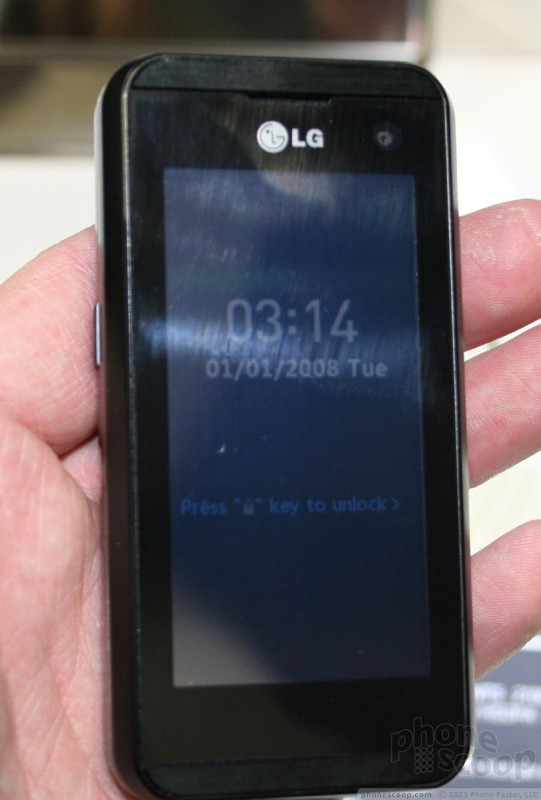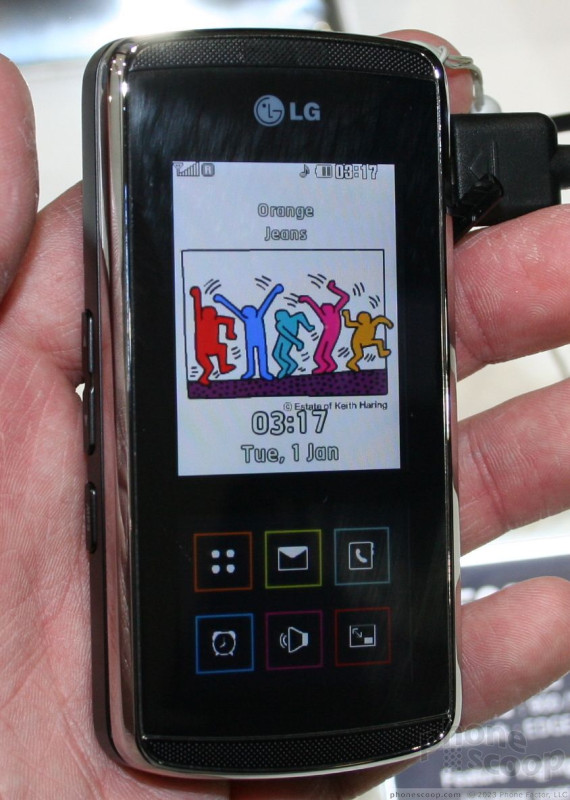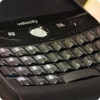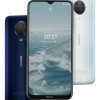MWC 2008
LG showed off three new phones in Barcelona. One of them was announced last week, but the KF600 and KF700 were new at the show. Both are slider phones that use touch for interacting with the phone's menus and applications.
KF700
The KF700 is a slider that is akin to the Prada phone. It has a large screen on the front that looks sharp is ready for video playback. LG is getting pretty good at making touchscreen phones that offer decent user interfaces and and other shortcuts to applications and content.
The KF700 is about the same size as the iPhone, but is a bit thicker. It has a slide-out numeric keypad for entering numbers and text information. Sliding the phone open requires just a gentle push of the thumb. The slide mechanism was solid and smooth. The numeric keys felt similar to those of the Venus. They offered good travel and feedback, and the keypad wasn't too cramped. The keys were nicely spaced out. The phone feels good in your hand and isn't too heavy. All the buttons along the side were easy to find and use. We had no issues with the microSD slot hatch.
On the left side/back of the phone is a jog dial that is used with a customizable shortcut menu. The dial sort of resembles what might have appeared on a transistor radio from the 60s. It is silver, and definitely stands out on the back of the phone. This was probably the cheapest aspect of the phone. The materials of this dial felt a little brittle. Otherwise, moving it with your thumb was easy, and it moves around the circular selector on the screen.
The user interface is one of the better ones we've seen on an LG phone. Since it hasn't been specified for any one carrier, it was devoid of operator decks, applications and so on. It is simple, clean and uses black and white icons on the screen. It was relatively responsive, though we did often have to perform multiple presses on the screen to open certain applications. This could be either a hardware of software issue.
Because the entire phone face is a touchscreen, LG brings a lot of the action items to the screen when using applications. The camera, for instance, has a lot of flexibility in what it can do to alter images as they are taken. All of the settings are intuitive to figure out and use.
The main menu uses tabs that are along the right side of the screen. Touching each of the tabs brings up a separate bunch of applications or tools on the phone.
In all, the KF700 is one of the better phones we've seen from LG. Unfortunately is is not meant for the North American market.
Here is a video tour of how it works:
KF600
Like the KF700, the KF600 is stylish, elegant and classy. It is essentially a GSM variation of the Venus. It features good materials, a silver and black appearance, and a nice alligator-textured back panel for easier gripping. Rather than sporting a full touch screen, the KF600 only goes halfway. The upper portion of the screen is a regular display with no touch capabilities. The lower portion of the screen replaces what would be the navigation cluster with a touch sensitive navigation system instead.
The KF600's touch screen navigation uses haptics to provide microvibration feedback to let you know you've made a selection. It is very prone to smudges, but works fairly well for navigating the phone's menus. The problem here is that even the haptics can't replace the feedback we're used to getting on a regular D-pad. This means navigating without looking at the phone is more difficult.
Sliding the phone open is easy, though with no ledge or anything else to catch your thumb on, you're definitely going to be touching the screen (and smudging it) a lot to get the phone open. The mechanism felt solid and the spring action helped to get it open and shut.
Once open, there is a regular 12-key keypad underneath with three extra buttons, the send, clear and power/end keys. It has a checkerboard-style appearance, and we found using the keys was easy. They felt good as you passed your thumb over them and with their slightly convex shape finding each key was a snap.
There are a number of buttons along the side of the phone. On the left is the volume/zoom toggle and a microphone key. On the right is the unlock key and camera key. The data port and microSD slot are also located along the sides of the phone.
With the phone closed, the navigation touch screen lets you jump to a few different applications, including contacts, messaging, the phone and a short cut menu. The shortcut menu brings up six little options in the navigation pane to let you jump to an application or task without having to access the main menu. Depending on which application or menu you are using, the entire make-up of this navigation panel will change and show different options.
With the main menu open, the navigation pane simply becomes a D-pad, with four arrows and a select key in the center and back key in the bottom right corner. Hitting any of the arrows will move the cursor/selector around, and provide haptic and visual feedback to let you know you've made a selection.
The KF600 has eight different themes to it. They are artistic in nature, and change not only the main display, but also the appearance of the control panel as well. Several of the themes feature animations complete with active screen savers. These themes let you customers the KF600 to a certain degree.
Here is a video tour of the phone:




















 CTIA 2008
CTIA 2008
 Samsung Refreshes Galaxy S Series with S Pen, New Cameras
Samsung Refreshes Galaxy S Series with S Pen, New Cameras
 iPhone 14 Plus Offers a Big Screen For Less
iPhone 14 Plus Offers a Big Screen For Less
 Samsung S24 Series Adds More AI, Updates the Hardware
Samsung S24 Series Adds More AI, Updates the Hardware
 Nokia Brings New G Series to US
Nokia Brings New G Series to US
 Nokia 6210 Navigator
Nokia 6210 Navigator
 Nokia 6220 Classic
Nokia 6220 Classic
 Nokia N96
Nokia N96

